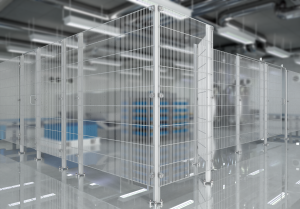How to plan protective enclosures for plants and machines correctly
Production in industrial and manufacturing companies is becoming increasingly automated. So what used to be done manually is now done by machines. To ensure safety there as well, machine protection is absolutely essential. This can be done in several ways. From individual covers to complete protective enclosures, the market offers various possibilities. Especially the protective enclosures offer extensive protection for man and machine and are therefore often used in production. But what do you have to consider when planning them?
Why do you need protective enclosures for machines?
Machines and systems in production facilities must primarily do one thing: function as problem-free as possible. This includes protecting the machine from accidental damage or wilful interference. Special protective enclosures for plant and machinery can help here. These delimit the plant within the production facility and thus keep vehicles or personnel at a distance.
The protective enclosures not only provide safety for the machine, but also protect employees. Machine safety with the help of protective enclosures also means protecting employees from possible dangers. These shield the machine within the production facility and thus keep vehicles or staff at a distance.
In addition to protecting people and machines, the housings also serve as sound and noise protection in the production facility.
Universal solution or special design?
The spectrum of protective equipment for industrial plants ranges from safety fences to complete machine enclosures. Depending on the application, there is a choice of numerous panel elements and protective grids that are suitable as protective enclosures in accordance with the Machinery Directive 2006/42/EC.
A distinction can be made between universal safety fence solutions for machines and individual custom-made products. There are advantages on both sides. Universal solutions are usually less expensive and are particularly suitable if the protective fence does not have to have any special requirements, but only serves as a distance protection device.
Custom-made products are again advantageous if the protective system must or should meet certain requirements which are not included as standard. These are then more expensive, but are adapted to the own requirements.
Create a catalog of requirements for your protective enclosure
Whether a universal solution or a custom-made product is more suitable cannot be answered in a generalized way, but depends on the individual circumstances. If a protective housing is required for the machine, a well-considered
Planning ahead. After all, not every system is equally suitable for every application.
In principle, there are many questions that you should ask yourself before installing a machine safety enclosure and which are relevant in different ways depending on the system. For example, is a door important because the machine must be accessible to employees on a regular basis? Should the fence have a certain height to reliably protect man and machine? Or should the protective elements be easy to install and extend so that they can be easily adapted in the future if necessary? It is also important to calculate the necessary size of the protective fence and the force it must withstand. So take your time to list the individual requirements for the protective fence and use this information to create a list of questions that will help you to approach the planning in a concrete way. Because if a supplier cannot meet one of the absolutely necessary requirements, it may be dropped as an option.
The right timing for installation
Once the choice of a protective enclosure has been made, the next step is to order and install the protective fence. Please keep in mind that your machine may have to be shut down during this process and production will not be possible during this time. It is therefore advisable to carry out the installation during normal maintenance work or at a time when the machine is less busy.
Since the installation of most safety enclosures is usually quite uncomplicated thanks to pre-assembled components, machine downtimes can be kept to a minimum.
Correct planning of machine protective housing
Machine protective enclosures are used to secure danger points at production plants. They are designed to protect both man and machine, which is why they are so important. The correct planning for the installation of a protective enclosure is therefore essential to ensure that it can fulfill its purpose in the best possible way. Therefore, take sufficient time for the planning of a machine protection. This is the only way to make a well-made decision that will pay off in the end.
.






